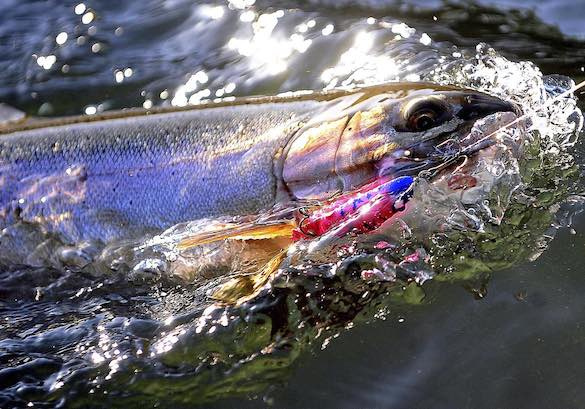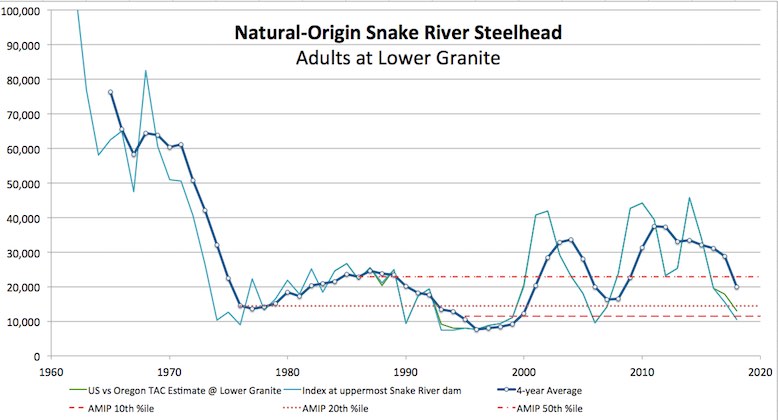forum
library
tutorial
contact

With A-Run Steelhead Not Living Up to Predictions,
Fish Managers Downgrade Forecast
by Eric Barker
Lewiston Tribune, August 31, 2019
|
the film forum library tutorial contact |

|
With A-Run Steelhead Not Living Up to Predictions,
by Eric Barker
|
The move, not unexpected, follows weeks of ugly steelhead counts
recorded at dams on the Snake and Columbia rivers.
 LEWISTON -- Fisheries managers have downgraded their forecast for the return of steelhead to the Snake and Columbia rivers.
LEWISTON -- Fisheries managers have downgraded their forecast for the return of steelhead to the Snake and Columbia rivers.
Daily fish counts at Lower Granite and Bonneville dams foreshadowed a decision by state, federal and tribal fisheries managers in the Northwest to downgrade their official forecast for the return of steelhead to the Columbia River and its tributaries, including the Snake River.
The move, not unexpected, follows weeks of ugly steelhead counts recorded at dams on the Snake and Columbia rivers. For example, for the past week steelhead passage at Bonneville Dam has numbered between 380 and 755 per day. The 10-year average for daily steelhead passage at Bonneville during the same time span ranges from 2,725 to 4,267.
At Lower Granite Dam on the Snake River, daily steelhead counts over the past week ranged from a low of 16 and a high of 36. The 10-year average for daily steelhead counts over the same period ranges from 220 to 281.
The numbers reflect the failure of A-run steelhead to meet preseason expectations. In response, fisheries managers in Washington reduced steelhead bag limits to one hatchery fish per day on the Snake, Grande Ronde, Tucannon, Touchet and Walla Walla rivers. The state also adopted regulations that require anglers fishing on the Snake River between its mouth and the Couse Creek Boat Ramp south of Asotin to release any steelhead 28 inches in length or longer. The bag limit and length restrictions take effect today.
Washington and Oregon extended a steelhead harvest closure below the Dalles Dam on the Columbia River through September. Idaho reduced steelhead bag limits to one per day last week and implemented requirements to release steelhead 28 inches or longer caught from the Clearwater River and its tributaries and the Snake River downstream of Couse Creek last week.
The new steelhead forecast, released earlier this week, calls for 86,000 A- and B-run fish to return at least as far as Bonneville Dam. The preseason forecast was a modest 118,200. Fisheries managers did not update the forecasts to reflect how many of the expected steelhead will belong to the A-run and how many to the B-run. The A-run returns earlier and those fish generally spend just one year in the ocean. The B-run fish are bigger and return later in the year after spending, on average, two years in the ocean.
The downgrade was based on the performance of A-run fish. B-run steelhead are just starting to show up at Bonneville Dam and fisheries managers won't know for some time if those fish will live up to the preseason forecast.
But even if they do meet expectations, the B-run is not likely change the forecast for the better. That is because fisheries managers are calling for only about 8,000 of the big steelhead to return to Bonneville Dam this year and only about 5,300 to Lower Granite Dam on the Snake River.
 "We weren't expecting a very big (B-) run, so any sort of a downgrade in that component is going to make it even more grim," said Alan Byrne, a fisheries biologist for the Idaho Department of Fish and Game at Boise. "But we probably need a few more weeks before we can say anything about that component."
"We weren't expecting a very big (B-) run, so any sort of a downgrade in that component is going to make it even more grim," said Alan Byrne, a fisheries biologist for the Idaho Department of Fish and Game at Boise. "But we probably need a few more weeks before we can say anything about that component."
Chris Donley, fish program manager for the Washington Department of Fish and Wildlife at Spokane, said wild steelhead are performing as expected, but hatchery fish are lagging. The difference in performance means this year's run to date has been dominated by fish anglers can't keep.
Through Tuesday, 1,929 steelhead had been counted at Lower Granite Dam since July 1. Of those, 1,315, or about 68 percent, were either wild or unclipped hatchery fish. Based on the 10-year average during the same time period, wild and unclipped steelhead should make up about 43 percent of the run. Wild steelhead are protected as threatened under the Endangered Species Act and anglers who catch them are required to let them go.
This year's steelhead run is the third in the row to perform well below most runs over the past two decades. The poor returns have led to bag-limit and size reductions and to acrimonious posturing between state fisheries managers, some conservation groups and anglers.
Fisheries managers suspect lingering poor conditions in the Pacific Ocean have led to low survival of the fish during their time at sea. They had hoped the A-run would see a modest rebound this year based on indications that ocean conditions are improving.
Donley said even with the disappointing steelhead numbers, anglers still have fishing opportunities. He said the fall chinook run is preforming as expected, and the coho run is also looking like it will live up to forecasts.
"At least we are in a good spot there," he said.
learn more on topics covered in the film
see the video
read the script
learn the songs
discussion forum
